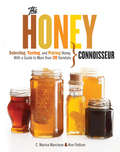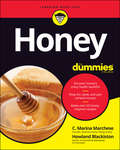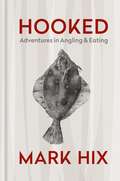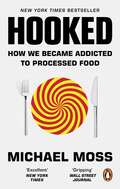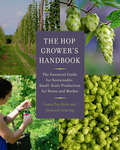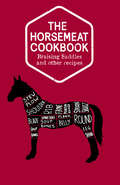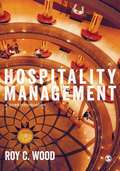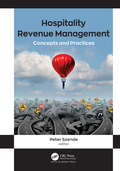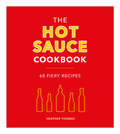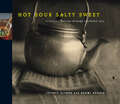- Table View
- List View
Honey Connoisseur: Selecting, Tasting, and Pairing Honey, With a Guide to More Than 30 Varietals
by C. Marina Marchese Kim FlottumFrom honey experts C. Marina Marchese and Kim Flottum comes this comprehensive introduction to the origin, flavor, and culinary uses of more than 30 varietals of honey, from ubiquitous clover to tangy star thistle to rich, smoky buckwheat Like wine, cheese, coffee, and chocolate, honey has emerged as an artisanal obsession. Its popularity at farmers' markets and specialty food stores has soared as retailers are capitalizing on the trend. The Honey Connoisseur teaches consumers everything they need to know about how to taste, select, and use a diverse selection of honey. After a brief explanation of how bees produce honey, the authors introduce the concept of terroir, the notion that soil, weather, and other natural phenomena can affect the taste of honey. As with wines, knowing the terroir of a honey varietal helps to inform an understanding of its flavor. The book goes on to give a thorough course in the origins of more than 30 different honeys as well as step-by-step instructions, how to taste honey, describe its flavor and determine what other flavors pair best with a particular honey. Also included are simple recipes such as dressings, marinades, quick-and-easy desserts, and beverages. Beautifully illustrated and designed, The Honey Connoisseur is the perfect book for foodies and locavores alike. Praise for The Honey Connoisseur: "Of all the near-perfect food we generally take for granted, honey suffers more than most (except for cheese). The Honey Connoisseur lays it all out on the table; Marina Marchese and Kim Flottum tell the whole story including its dark side in an eloquent style. The reader will never look at the honey jar the same way." -- Max McCalman, author of Mastering Cheese, Cheese: Connoisseur's Guide to the World's Best, and The Cheese Platebr> "Eureka! This is the book I've been looking for. As a restaurateur who has traveled high and low in search of the world's finest wines, I have always respected the role terroir plays in creating and nurturing a region's culinary personality. Ever since I took up beekeeping, I've been on the hunt for the definitive guide to the essence of honey: how to taste it, which local factors influence its flavor, and most importantly for me, how to pair it with other ingredients like an expert." -- Julian Niccolini, Owner of The Four Seasons Restaurant, New York City "With the authors' depth of knowledge, I cannot think of a better resource on honey. This book makes me want to bake with all the varieties. Finally, a honey bible!  The Honey Connoisseur is truly a great book." -- John Barricelli, author of The Seasonal Baker and The Sono Baking Company Cookbook "Marina Marchese and Kim Flottum's knowledge of this fascinating and increasingly popular subject is unparalleled.  Together, they have composed the preeminent book about honey and its regional culinary food pairings." -- Nicholas Coleman, Chief Olive Oil Specialist, Eataly NYC
Honey For Dummies
by C. Marina Marchese Howland BlackistonGet in on the ground level of the next artisan food obsession—honey! Just like wine, cheese, beer or coffee, honey is an artisan food with much to be discovered. Whether you're interested in tasting the various varietals, using it as a cure, or harvesting your own, Honey For Dummies is the guide for you. This book reveals the deep and complex world of honey, its diverse floral sources, and its surprising range of colors, smells, and flavors. You will learn about over 50 single-origin honeys, their sensory profiles, where they are produced and where to buy them. Discover how to taste and evaluate honey using the same methods as professional honey sensory expert. Understand how honey is produced by honeybees, and how beekeepers harvest, and bottle this liquid gold. You'll also discover the historical role honey has played around the world in folklore, religions, and economies. From its health benefits, to recipes, to food pairings, this complete guide covers all things honey! Honey is the latest food trend that can be found at farmers' markets, specialty food shops and on the menu of restaurants. It is produced from bees in every state and just about every country on the planet. Let Honey For Dummies accompany you on your sweet adventure! Discover the rich and complex world of single-origin honey Learn about honey's composition and its myriad health benefits Acquire the skills to taste honey like a pro then how to perfectly pair honeys with all foods Try the book's many wonderful recipes that incorporate honey Honey For Dummies is the perfect companion for every chef, brewer, homesteader, beekeeper or honey lover.
Honey For Dummies
by C. Marina Marchese Howland BlackistonGet in on the ground level of the next artisan food obsession—honey! Just like wine, cheese, beer or coffee, honey is an artisan food with much to be discovered. Whether you're interested in tasting the various varietals, using it as a cure, or harvesting your own, Honey For Dummies is the guide for you. This book reveals the deep and complex world of honey, its diverse floral sources, and its surprising range of colors, smells, and flavors. You will learn about over 50 single-origin honeys, their sensory profiles, where they are produced and where to buy them. Discover how to taste and evaluate honey using the same methods as professional honey sensory expert. Understand how honey is produced by honeybees, and how beekeepers harvest, and bottle this liquid gold. You'll also discover the historical role honey has played around the world in folklore, religions, and economies. From its health benefits, to recipes, to food pairings, this complete guide covers all things honey! Honey is the latest food trend that can be found at farmers' markets, specialty food shops and on the menu of restaurants. It is produced from bees in every state and just about every country on the planet. Let Honey For Dummies accompany you on your sweet adventure! Discover the rich and complex world of single-origin honey Learn about honey's composition and its myriad health benefits Acquire the skills to taste honey like a pro then how to perfectly pair honeys with all foods Try the book's many wonderful recipes that incorporate honey Honey For Dummies is the perfect companion for every chef, brewer, homesteader, beekeeper or honey lover.
Honey in Food Science and Physiology
by Rajesh Kumar Sanju Bala Dhull Younis Ahmad Hajam Arup GiriThis book highlights the science underlying honey, which is central to an understanding of conventional medicine or ingredients of food used mostly in all societies and it is attracting increasing interest among food scientists and professionals worldwide. Honey, wax, propolis and royal jelly also have significant roles in various nutraceutical and pharmaceutical products and this book provides collective information and practical approaches regarding all characteristic features of honey and its applications as functional food and medicines. Not only does this book explain the comprehensive knowledge of honey and its medicinal properties based on current researched evidence, it also explores the contribution of honey in the food science and medicine industry as a significant part of nutraceuticals and functional food research. Written by leading scientists in the field, the book will be a valuable resource for students and researchers in the fields of food chemistry, nutritional science, taste physiology, and neuroscience, as well as for professionals in the food industry.
Honey Sapiens: Human Cognition and Sugars - the Ugly, the Bad and the Good
by Mike McInnesA revelatory look at the extensive damage most sugars do to the human brain, from conception through to old age and focusing on developmental problems, obesity, metabolic syndrome/diabetes, and dementia. Drawing on global research often ignored in the UK and US, honey emerges as the one 'good' sugar thanks to its truly amazing micro-nutrient content. Every human function requires energy, and no organ more so than the brain which accounts for only 2% of body weight but consumes 20% of total body energy production. Without a sufficient energy supply we lose the ability to think clearly, react quickly or make good decisions. In Honey Sapiens, pharmacist Mike McInnes explores human energy metabolism and how this is affected negatively by refined sugars and positively by honey. In particular, his more than 20 years of research into sports nutrition have shown him the central importance of the little-known enzyme glutamine synthetase and how this is degraded by refined sugars, a key factor in memory loss, dementia and neurocognitive problems in the young and old and in utero. Drawing on an internationally diverse range of published findings, often ignored in English-speaking countries, he explains this causal pattern and the solutions, including the unrivalled part honey and the bioflavonoids it contains can play in supporting brain function long-term and protecting it from refined sugar degradation.
Hooch: Simplified Brewing, Winemaking, and Infusing at Home
by Scott MeyerFor anyone who has considered brewing a batch of beer or mead at home, or making a custom barrel of wine with local fruit, this thorough guide will clear a path to the bottle. It demystifies the process: from planting hops and fruits to pruning, harvesting, fermenting, flavoring, and bottling one-of-a-kind drinks from your own backyard. It serves as a starting point not only for wines and beers, but also hard ciders, meads, and infusions, and even touches on at-home distillingPerfect for the city-dweller, urban gardener, or anyone with limited space and a desire to make custom concoctions, Hooch offers projects to suit any lifestyle. With recipes for brews made from grapes, hops, and herbs, DIY boozers will find everything they need to begin a brewing journey.
HOOKED: Adventures in Angling and Eating
by Mark HixHooked delves into the exciting fishing adventures of celebrated chef, restaurateur and food writer Mark Hix, opening with the story of his first catch, age 8, being cooked for supper by his grandmother - the catalyst for what has become his passion.You will be regaled with tales of extraordinary fishing expeditions at home and afar, from the banks of the Dumfriesshire coast to Tuscany's Porto Ercole, with each trip ending with a feast - be it the catch of the day (if all went to plan), or something found and foraged if the need arises (always have a back-up plan). Hooked features both exotic and humble dishes such as Hot stone salmon, Barracuda & pineapple ceviche, Trout kedgeree and Mahi mahi sashimi.Weaved into the narrative are the infectious, and unexpected, joys of fishing and what it does for you. Hint: it's not necessarily about the fish.Featured locations:EnglandScotlandIrelandItalyNorwayFloridaThe BahamasSouth AfricaJapanAustraliaNew Zealand
Hooked: How Processed Food Became Addictive
by Michael Moss'No one has done more to reveal the intentional and underhanded ways in which food companies manipulate our desires and eating habits than Michael Moss' -- Mark Bittman'A very important read for anyone who cares about their health' -- Sylvia Tara'Moss shows us how we can win our freedom back' -- Charles DuhiggEveryone knows how hard it can be to maintain a healthy diet. But what if some of the decisions we make about what to eat are beyond our control? Is it possible that food is addictive, like drugs or alcohol? And to what extent does the food industry know, or care, about these vulnerabilities? In Hooked, Pulitzer Prize-winning investigative reporter Michael Moss sets out to answer these questions and to find the true peril in our food. Moss uses the latest research on addiction to uncover the shocking ways that food, in some cases, is even more addictive than alcohol, cigarettes, and drugs. Our bodies are hardwired for sweets, so food giants have developed fifty-six types of sugar to add to their products and ways to exploit our evolutionary preference for fast, ready-to-eat foods. Moss goes on to show how the processed food industry -- including major companies like Nestlé, Mars, and Kellogg's -- has not only tried to hide the addictiveness of food but to actually exploit it. As obesity rates continue to climb, manufacturers are now claiming to add ingredients that can effortlessly cure our compulsive eating habits.A gripping account of the legal battles, insidious marketing campaigns, and cutting-edge food science that have brought us to our current public health crisis, Hooked lays out all that the food industry is doing to exploit and deepen our addictions, and shows us why what we eat has never mattered more.
The Hop Grower's Handbook: The Essential Guide for Sustainable, Small-Scale Production for Home and Market
by Laura Ten Eyck Dietrich GehringWith information on siting, planting, tending, harvesting, processing, and brewing It’s hard to think about beer these days without thinking about hops. The runaway craft beer market’s convergence with the ever-expanding local foods movement is helping to spur a local-hops renaissance. The demand from craft brewers for local ingredients to make beer—such as hops and barley—is robust and growing. That’s good news for farmers looking to diversify, but the catch is that hops have not been grown commercially in the eastern United States for nearly a century. Today, farmers from Maine to North Carolina are working hard to respond to the craft brewers’ desperate call for locally grown hops. But questions arise: How best to create hop yards—virtual forests of 18-foot poles that can be expensive to build? How to select hop varieties, and plant and tend the bines, which often take up to three years to reach full production? How to best pick, process, and price them for market? And, how best to manage the fungal diseases and insects that wiped out the eastern hop industry 100 years ago, and which are thriving in the hotter and more humid states thanks to climate change? Answers to these questions can be found in The Hop Grower’s Handbook—the only book on the market about raising hops sustainably, on a small scale, for the commercial craft beer market in the Northeast. Written by hop farmers and craft brewery owners Laura Ten Eyck and Dietrich Gehring, The Hop Grower’s Handbook is a beautifully photographed and illustrated book that weaves the story of their Helderberg Hop Farm with the colorful history of New York and New England hop farming, relays horticultural information about the unusual hop plant and the mysterious resins it produces that give beer a distinctively bitter flavor, and includes an overview of the numerous native, heirloom, and modern varieties of hops and their purposes. The authors also provide an easy-to-understand explanation of the beer-brewing process—critical for hop growers to understand in order be able to provide the high-quality product brewers want to buy—along with recipes from a few of their favorite home and micro-brewers. The book also provides readers with detailed information on: • Selecting, preparing, and designing a hop yard site, including irrigation; • Tending to the hops, with details on best practices to manage weeds, insects, and diseases; and, • Harvesting, drying, analyzing, processing, and pricing hops for market. The overwhelming majority of books and resources devoted to hop production currently available are geared toward the Pacific Northwest’s large-scale commercial growers, who use synthetic pesticides, fungicides, herbicides, and fertilizers and deal with regionally specific climate, soils, weeds, and insect populations. Ten Eyck and Gehring, however, focus on farming hops sustainably. While they relay their experience about growing in a new Northeastern climate subject to the higher temperatures and volatile cycles of drought and deluge brought about by global warming, this book will be an essential resource for home-scale and small-scale commercial hops growers in all regions.
Hopped Up: How Travel, Trade, and Taste Made Beer a Global Commodity
by Jeffrey M. PilcherA lively history of beer and brewing traditions as globally connected commodities created through borrowing and exchange from precapitalist times to the present. Virtually every country has a bestselling or iconic national beer brand: from Budweiser in the United States and Corona in Mexico, to Tsingtao in China and Heineken in Holland. Yet, with the sole exception of Ireland's Guinness, every label represents the same style: light, crisp, clear, Pilsner lager. The global spread of lager can be told as a story of Western cultural imperialism: a European product travels through merchants, migrants, and imperialists to upend local patterns and transform faraway consumers' tastes. But this modern beer is just as much a product of globalization, invented and reinvented around the world. While distinctive craft beers such as London Porter, India Pale Ale, and Belgian sour ales have been revived by aficionados over the past half-century, they too have globalized through the same circuits of trade, migration, and knowledge that carried lager. Here eminent food historian Jeffrey M. Pilcher narrates the brewing traditions and contemporary production of beer across Europe, North America, Africa, Asia, and Latin America--from the fermented beverages of precapitalist societies to the present. Over the centuries, he shows, the exchange of technological advances in brewing contributed to regional divergences and convergences in beer varieties, but always in tandem with other social and cultural developments. Unique local products, often homebrewed by women, were transformed into homogenous global commodities as giant brewing factories exported their beers using new refrigeration technology, railroads, and steamships. Industrial food processing helped to recast strong flavors as a source of potential contamination, turning lager, with its clean, fresh taste, into a symbol of hygiene and civilization. Local elites demonstrated their modernity and sophistication by opting for chilled lagers over traditional beverages. These beers became so standardized that most consumers could not tell the difference between them, leading to cutthroat competition that bankrupted countless firms. Over the past half-century, the global concentration of the brewing industry has spawned a reaction among those seeking to return brewing to the local, artisanal, and communitarian roots of the premodern alehouse, but microbrewers have often been driven by the same capitalist quest for profit and expansion. Based on a wealth of multinational archives and industry publications, Hopped Up explores not only how humans have made beer but also how consumers--from nobility and clergy in the past to those raising a pint today--have used beer to make meaning in their lives.
Hopped Up: How Travel, Trade, and Taste Made Beer a Global Commodity
by Jeffrey M. PilcherA lively history of beer and brewing traditions as globally connected commodities created through borrowing and exchange from precapitalist times to the present. Virtually every country has a bestselling or iconic national beer brand: from Budweiser in the United States and Corona in Mexico, to Tsingtao in China and Heineken in Holland. Yet, with the sole exception of Ireland's Guinness, every label represents the same style: light, crisp, clear, Pilsner lager. The global spread of lager can be told as a story of Western cultural imperialism: a European product travels through merchants, migrants, and imperialists to upend local patterns and transform faraway consumers' tastes. But this modern beer is just as much a product of globalization, invented and reinvented around the world. While distinctive craft beers such as London Porter, India Pale Ale, and Belgian sour ales have been revived by aficionados over the past half-century, they too have globalized through the same circuits of trade, migration, and knowledge that carried lager. Here eminent food historian Jeffrey M. Pilcher narrates the brewing traditions and contemporary production of beer across Europe, North America, Africa, Asia, and Latin America--from the fermented beverages of precapitalist societies to the present. Over the centuries, he shows, the exchange of technological advances in brewing contributed to regional divergences and convergences in beer varieties, but always in tandem with other social and cultural developments. Unique local products, often homebrewed by women, were transformed into homogenous global commodities as giant brewing factories exported their beers using new refrigeration technology, railroads, and steamships. Industrial food processing helped to recast strong flavors as a source of potential contamination, turning lager, with its clean, fresh taste, into a symbol of hygiene and civilization. Local elites demonstrated their modernity and sophistication by opting for chilled lagers over traditional beverages. These beers became so standardized that most consumers could not tell the difference between them, leading to cutthroat competition that bankrupted countless firms. Over the past half-century, the global concentration of the brewing industry has spawned a reaction among those seeking to return brewing to the local, artisanal, and communitarian roots of the premodern alehouse, but microbrewers have often been driven by the same capitalist quest for profit and expansion. Based on a wealth of multinational archives and industry publications, Hopped Up explores not only how humans have made beer but also how consumers--from nobility and clergy in the past to those raising a pint today--have used beer to make meaning in their lives.
Hops and Glory: One man's search for the beer that built the British Empire
by Pete BrownThe original India Pale Ale was pure gold in a glass; a semi-mythical beer specially invented, in the 19th century, to travel halfway around the world, through storms and tropical sunshine, and arrive in perfect condition for a long, cold drink on an Indian verandah. But although you can still buy beers with ‘IPA’ on the label they are, to be frank, a pale imitation of the original. For the first time in 140 years, a keg of Burton IPA has been brewed with the original recipe for a voyage to India by canal and tall ship, around the Cape of Good Hope; and the man carrying it is the award-winning Pete Brown, Britain’s best beer write. Brazilian pirates and Iranian customs officials lie ahead, but will he even make it that far, have fallen in the canal just a few miles out of Burton? And if Pete does make it to the other side of the world with ‘Barry’ the barrel, one question remains: what will the real IPA taste like? Weaving first-class travel writing with assured comedy, Hops and Glory is both a rollicking, raucous history of the Raj and a wonderfully entertaining, groundbreaking experiment to recreate the finest beer ever produced.
Horrid Henry's Food: A Horrid Factbook (Horrid Henry #1)
by Francesca SimonPacked with fun and freaky facts, this is the perfect guide to everything you ever wanted to know (and lots of things you might never have wanted to know) about FOOD - Horrid Henry style!
The Horsemeat Cookbook: Braising Saddles And Other Recipes
by Chris WindleThe word is out: horses really are for courses. Interest in cooking with horsemeat has been piqued by the recent horsemeat scandal, with butchers across the UK reporting customers curious to try it for themselves. Destined to become a firm favourite, horse is galloping onto the nation’s menus. Across the world it is considered a delicacy, a lean and delicious meat and a great addition to a stable diet. So the time has come to take the reins and get cooking: The Horsemeat Cookbook is a fun, light-hearted recipe book aimed at the gift book market and those interested in cooking with this healthy, low–calorie meat. Recipes will include classics such as the Italian Pastissada de Caval and Pot-au-feu de cheval, a traditional French horse stew; Yuk Hui, a Korean raw horse salad; and Beshbarmak, the national dish of Khazakhstan.Complete with information on nutritional benefits, cooking times and guides on which cuts to use for which dish, with The Horsemeat Cookbook your family and dinner guests will be chomping at the bit for more. And along with all that, there are even some horsemeat jokes thrown in for good measure.
Hospitality Management: A Brief Introduction
by Roy C WoodAn innovative and cross-cutting approach to Hospitality that examines the fundamentals of the subject in a concise and commendable way. Roy Wood's academic and practitioner expertise is brought to bear on this succinct synthesis of the subject that will quickly become a must read for all students and academics in the hospitality area. - Professor Stephen J. Page, Bournemouth.
Hospitality Management: A Brief Introduction (PDF)
by Roy C WoodAn innovative and cross-cutting approach to Hospitality that examines the fundamentals of the subject in a concise and commendable way. Roy Wood's academic and practitioner expertise is brought to bear on this succinct synthesis of the subject that will quickly become a must read for all students and academics in the hospitality area. - Professor Stephen J. Page, Bournemouth.
Hospitality Revenue Management: Concepts and Practices
by Peter SzendeThis new textbook, Hospitality Revenue Management: Concepts and Practices, provides a comprehensive, in-depth introduction to the basic concepts and best practices of hospitality revenue management. With a real-world, hands-on approach, the book places students in the role of a revenue manager striving to succeed in an ever-changing hospitality business environment. The book takes a unique multi-author, collaborative approach, with chapters from outstanding industry leaders who share their experience and provide the information necessary to arm students with the most up-to-date tools and methods they to be effective in the hospitality revenue management field. The chapters cover the important topics in hospitality revenue management, including hotel pricing, hotel segmentation, distribution channels, competitive analysis, hotel forecasting, performance analysis, market data, supply and demand management, and more.
Hospitality Revenue Management: Concepts and Practices
by Peter SzendeThis new textbook, Hospitality Revenue Management: Concepts and Practices, provides a comprehensive, in-depth introduction to the basic concepts and best practices of hospitality revenue management. With a real-world, hands-on approach, the book places students in the role of a revenue manager striving to succeed in an ever-changing hospitality business environment. The book takes a unique multi-author, collaborative approach, with chapters from outstanding industry leaders who share their experience and provide the information necessary to arm students with the most up-to-date tools and methods they to be effective in the hospitality revenue management field. The chapters cover the important topics in hospitality revenue management, including hotel pricing, hotel segmentation, distribution channels, competitive analysis, hotel forecasting, performance analysis, market data, supply and demand management, and more.
The Hostess Handbook: A Modern Guide to Entertaining
by Maria ZizkaFrom the author of The Newlywed Table, this helpful handbook offers readers 100 easy entertaining recipes, party planning advice, and curated menus to pull off the most delicious and delightful of gatherings, from an epic holiday bash to a casual get-together in the backyard, or an inspired dinner party. Ready to throw a dinner party? It&’s easier than you think. With 100 crowd-pleasing recipes and expert tips and tricks, The Hostess Handbook shows how to create an event that&’s warm, joyous, and imbued with the special glowy feeling of a celebration that we never want to end. Everything you need to know is here. How to plan a fantastic menu with foolproof recipes for finger foods, make-ahead mains (because you don&’t want to be in the kitchen when your guests arrive), and festive desserts. How to get your home party-ready, whether hosting two people or twenty, with primers on setting the table, the art of serving, and flower arranging. And drinks, of course—including recipes for both classic cocktails and delicious nonalcoholic libations. Cheers!
Hot and Cold Theory: The Path Towards Personalized Medicine (Advances in Experimental Medicine and Biology #1343)
by Maryam YavariThis book is about the theory of Hot and Cold, a mutual fundamental base of traditional medicines all around the world. The theory describes the dynamic balance state of the body on the axis of hot and cold for each individual and proposes the fact that deviation from this equilibrium is a predisposing factor for diseases. Such an approach helps practitioners to provide treatments tailored to the patient’s condition, not the disease. This book, for the first time, has gathered native descriptions of Hot and Cold theory in different traditional medicines, including traditional Chinese medicine, Persian (Humoral, Unani) medicine, Ayurvedic medicine and Latin American and Caribbean medicines. After defining the common ground, contemporary research - in nutrition, pharmacology, physiology and systems biology - has been explored using scientific methodology. This work is the result of an international collaboration of more than 30 scientists and scholars with high reputations in their fields. Hot and Cold theory, as a holistic individualized approach in prevention, diagnosis and treatment, can be merged into the novel fast-paced concepts in systems biology and precision medicine. Through this bridge, the authors propose that the Hot and Cold theory should be revisited more deeply by medical scientists, who are the main audience of this book, to pave the way towards integrated holistic personalized medicine.
Hot Dog!: The Wonderful World Of The Wiener
by Andy LynesThe humble hot dog has become a stellar street-food sensation. Long gone are the days in which a squirt of ketchup or mustard made for a well-dressed dog; today's hot dog is more likely to be brought alive with kimchi, sauerkraut or satay sauce. Hot Dog! is a mouthwatering celebration of the hot dog and its illustrious history, from its Germanic roots through to its arrival in America where it was quickly adopted as the ball-park convenience food of choice. Explore exciting recipes for gourmet dogs, from Currywurst to Spanish Dogs (with grilled chorizo), as well as the ultimate classic recipes. You can also order up delicious buns, sides and sauces – from Brioche to Pretzel Buns, Potato Salad to Chilli-cheese Fries, and Sweet Pickle Relish to homemade Ketchup. All of your quick-fire questions will be answered: Where did that name come from? What exactly is a corn dog? Is it ever OK to use a knife and fork? (No.) Loaded with irresistible recipes and fascinating nuggets of wiener trivia, from Barack Obama's perfect hot dog to why the hot dog was one of the first foods enjoyed in space, this is the ultimate resource for every hot dog aficionado.
Hot Sauce!: Techniques for Making Signature Hot Sauces, with 32 Recipes to Get You Started; Includes 60 Recipes for Using Your Hot Sauces
by Jennifer Trainer ThompsonIf you can&’t stand the heat, get out of the kitchen! From mild to blistering, renowned author Jennifer Trainer Thompson offers 32 recipes for making your own signature hot sauces, as well as 60 recipes that use homemade or commercial hot sauces in everything from barbeque and Buffalo wings to bouillabaisse and black bean soup. Try making spicy chowders, tacos, salads, and seafood — even scorchingly delicious cocktails. Bring your own handcrafted heat to your next barbecue and feel the burn!
The Hot Sauce Cookbook
by Heather ThomasAddicted, obsessed, devoted. No meal is safe from a hot sauce addict. They’ve got it everywhere, in their fridge, in their pantry, even in their bag, swag! These 60 recipes are sure to satiate cravings at every mealtime.No longer relegated to the side of the plate, hot sauce is now the star of the show! So, dive into this cookbook for fantastically fiery dishes including Chilli-fried eggs, Hot Sauce Buffalo Wings, Sriracha Buttered Shrimp, Harissa Chicken Shawarma Wraps, Crunchy Thai Salad, and even sweet treats such as Chilli Chocolate Brownies and Mexican Hot Chocolate for die-hard hot sauce addicts.
Hot Sour Salty Sweet: A Culinary Journey Through Southeast Asia
by Jeffrey Alford Naomi DuguidLuminous at dawn and dusk, the Mekong is a river road, a vibrant artery that defines a vast and fascinating region. Here, along the world's tenth largest river, which rises in Tibet and joins the sea in Vietnam, traditions mingle and exquisite food prevails. Award-winning authors Jeffrey Alford and Naomi Duguid followed the river south, as it flows through the mountain gorges of southern China, to Burma and into Laos and Thailand. For a while the right bank of the river is in Thailand, but then it becomes solely Lao on its way to Cambodia. Only after three thousand miles does it finally enter Vietnam and then the South China Sea. It was during their travels that Alford and Duguid—who ate traditional foods in villages and small towns and learned techniques and ingredients from cooks and market vendors—came to realize that the local cuisines, like those of the Mediterranean, share a distinctive culinary approach: Each cuisine balances, with grace and style, the regional flavor quartet of hot, sour, salty, and sweet. This book, aptly titled, is the result of their journeys. Like Alford and Duguid's two previous works, Flatbreads and Flavors ("a certifiable publishing event" —Vogue) and Seductions of Rice ("simply stunning"—The New York Times), this book is a glorious combination of travel and taste, presenting enticing recipes in "an odyssey rich in travel anecdote" (National Geographic Traveler). The book's more than 175 recipes for spicy salsas, welcoming soups, grilled meat salads, and exotic desserts are accompanied by evocative stories about places and people. The recipes and stories are gorgeously illustrated throughout with more than 150 full-color food and travel photographs. In each chapter, from Salsas to Street Foods, Noodles to Desserts, dishes from different cuisines within the region appear side by side: A hearty Lao chicken soup is next to a Vietnamese ginger-chicken soup; a Thai vegetable stir-fry comes after spicy stir-fried potatoes from southwest China. The book invites a flexible approach to cooking and eating, for dishes from different places can be happily served and eaten together: Thai Grilled Chicken with Hot and Sweet Dipping Sauce pairs beautifully with Vietnamese Green Papaya Salad and Lao sticky rice. North Americans have come to love Southeast Asian food for its bright, fresh flavors. But beyond the dishes themselves, one of the most attractive aspects of Southeast Asian food is the life that surrounds it. In Southeast Asia, people eat for joy. The palate is wildly eclectic, proudly unrestrained. In Hot, Sour, Salty, Sweet, at last this great culinary region is celebrated with all the passion, color, and life that it deserves.
Hotel Chocolat: A New Way Of Cooking With Chocolate
by Hotel ChocolatChocolate is one of our most popular ingredients - both to eat and to cook with. But how many of us know how truly versatile it is? Hotel Chocolat, the UK's leading chocolatier, has pioneered 'cocoa cuisine': a new way of cooking with chocolate because, athough we know chocolate as a sweet ingredient, cocoa was originally used in savoury recipes. In fact, cocoa is a 'super-ingredient' with many layers of flavour and plenty of goodness too, and and this book showcases its many flavours and nuances with over 100 innovative chocolate recipes, both sweet and savoury.Hotel Chocolat has created energy-boosting recipes for breakfast, savoury recipes that enhance meat and fish dishes as well as give texture and depth to salads and snacks. And of course, not forgetting the hedonistic qualities that we love so much - with seductive bakes and puddings for all tastes.Find out too how to use the whole bean, from the shell to the nibs, cocoa powder to bar. And how to roast your own beans and even create a bar of your own. Uniquely, each recipe has a Cocoa Factor to indicate the depth of flavour as well as the cocoa percentage and region that will best suit the dish. Angus Thirlwell, Hotel Chocolat's visionary founder, will also take you through the story of chocolate from pod to plate.Welcome to cocoa cuisine!
